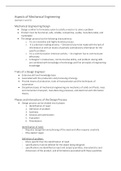Aspects of Mechanical Engineering
(Lecture 2 and 3)
Mechanical Engineering Design
• Design is either to formulate a plan to satisfy a need or to solve a problem
• Product must be functional, safe, reliable, competitive, usable, manufacturable, and
marketable
• The design process has the following characteristics:
o It is an innovative and highly iterative process.
o It is a decision making process. – Decisions have to be made with the lack of
information or with an excess of partially contradictory information for the
specific problem.
o It is a communication-intensive activity. – An engineer has to communicate
effectively.
o A designer’s creativeness, communicative ability, and problem solving skills
are combined with knowledge of technology and first principles of engineering
knowledge
Traits of a Design Engineer:
• Extensive skill and knowledge base
• Associated with the production and processing of energy
• Provide means of production, tools of transportation and the techniques of
automation
• Disciplinary bases of mechanical engineering are mechanics of solids and fluids, mass
and momentum transport, manufacturing processes, and electrical and information
theory
Phases and Interactions of the Design Process:
• Design process can be divided into 6 phases
1. Identification of need
2. Definition of problem
3. Synthesis
4. Analysis and optimization
5. Evaluation
6. Presentation
Identification of need:
- Requires recognition and phrasing of the need and often requires creativity
- May appear vague
Definition of problem:
- More specific than the identification of need.
- specifications must be defined for the object being designed.
- specifications are identified as input and output quantities, characteristics and
dimensions of the product, and all limitations associated with these quantities.
, - specifications influences a number of variables such as costs, the number of units
to be manufactured, the expected life, the range, the operating temperature and
the reliability.
- Implied specifications are a result of the designer’s environment or due to the
nature of the problem itself.
Examples of implied specifications are the available manufacturing processes and
facilities of a certain plant. These limit the designer’s freedom.
Synthesis
- Various concepts and ideas must be proposed
- These concepts and ideas are also investigated and quantified in terms of the
established metrics.
- Schemes that do not survive the analysis are revised, improved or rejected
- Synthesis and analysis and optimisation are closely and iteratively related
Analysis and optimisation
- Involves the construction and devising of abstract models of the system that will
allow some mathematical analyses to be developed.
- we hope simulate real physical systems as closely as possible
Evaluation
- This usually involves testing of the prototype through a rigorous testing
procedure. - Reveals whether the product satisfies the need.
- Questions to consider:
o Is it reliable?
o Will it compete successfully with similar products?
o Is it economical to manufacture and use?
o Can it be easily maintained and adjusted?
o Can profit be made from its sale or use?
o Will this product result in product-liability lawsuits?
Presentation
- Present the product or service to the stakeholders (administrative, management
or supervisory persons).
- Opportunity to sell or show that the presented solution is a better than current
solutions
Design Consideration
• characteristics that significantly influences the design of a component
• Functionality • Weight
• Strength/stress • Life expectancy
• Distortion/deflection/stiffness • Noise
• Wear • Styling
• Corrosion • Shape
• Safety • Size
• Reliability • Control
• Thermal properties
, • Utility
• Cost
• Friction
Design Tools and Resources
• Computer-aided design (CAD) software enables the development of three-
dimensional (3D) designs. The CAD software allows conventional two-dimensional
orthographic views with automatic dimensioning to be produced from these 3D
designs.
• Caution: Computer software is not a substitute for the human thought process. The
computer software is available to assist you to find a solution to the problem
Acquiring Technical Information
• Libraries and engineering dictionaries and encyclopaedias, textbooks, monographs,
handbooks, indexing and abstract services, journals, translations, technical reports,
patents, and business sources/brochures/catalogues.
• Professional societies such as American Society of Mechanical Engineers,
• Commercial vendor catalogues, technical literature, test data, samples, and cost
information.
• The internet – access websites associated with the above mentioned sources
Design Engineer’s Professional Responsibilities
• required to satisfy the needs of customers in the form of management, clients,
consumers,
• engineer must accomplish this in a competent, responsible, ethical, and professional
manner
• Communication skills must be developed
• following action steps will help you develop a systematic approach:
o Understand the problem: Defining the problem is probably the most important
step in the engineering design process. The problem statement must be a
well-constructed statement.
o Identify the knowns: Based on the refined problem statement, identify what
information is known and relevant.
o Identify the unknowns and formulate the solution strategy: State what must be
determined and the order in which the unknowns will be investigated. Make
use of sketches concerning the component and develop flowcharts that
sequentially describe how to arrive at the final solution.
o State all assumptions and decisions. Design problems, in reality, generally do
not have unique, ideal, closed form solutions. Selections concerning the
choice of materials, and heat treatments, require decisions. Analyses require
assumptions and all assumptions and decisions must be identified and
recorded.
o Analyse the problem. When analysing the problem, ensure that the sources of
all equations, tables, charts, software results, etc. have been referenced. The





